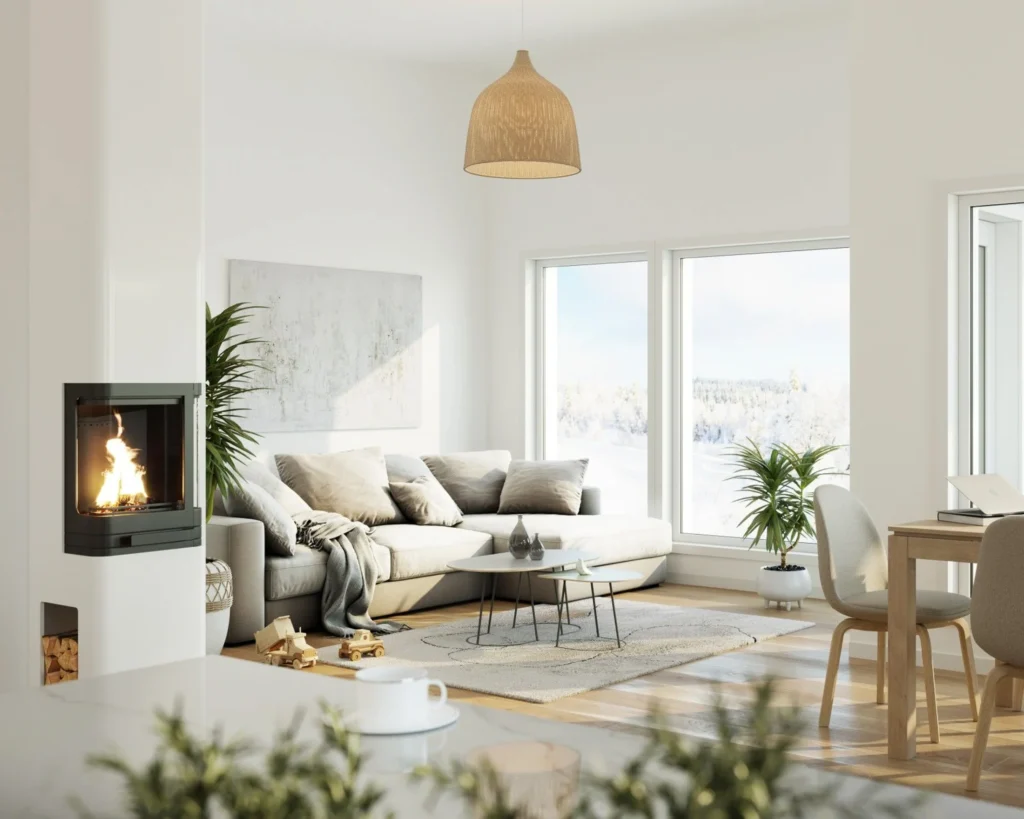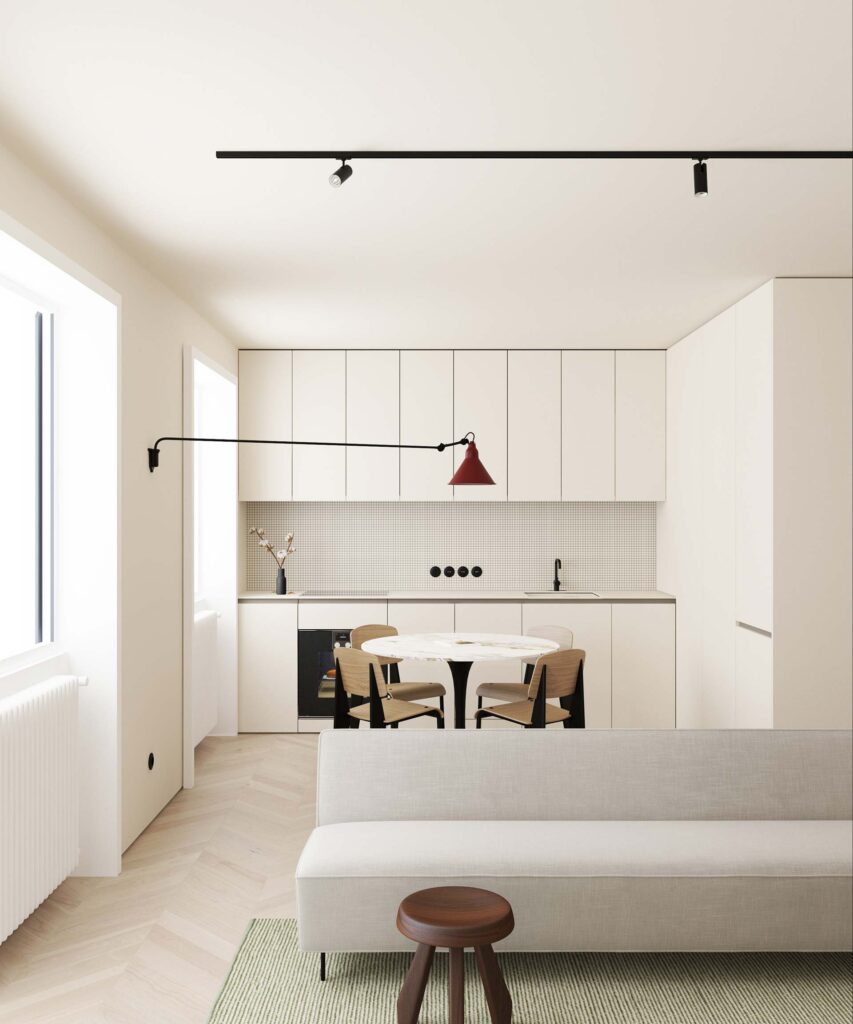Why Negative Spaces in Interior Design Make Your Home Feel Peaceful
When people think of interior design, they often picture colours, furniture, and accessories. Rarely do they stop to consider what is not there. Yet it is the space between objects, the nothingness that surrounds them, that often makes the difference between a cluttered room and one that feels calm, balanced, and beautiful. This principle is known as negative space in interior design, and it is one of the most powerful yet overlooked tools available.
Frida Ramstedt, in her book The Interior Design Handbook, reminds us that interiors are not just about filling a room with beautiful objects. Instead, they are about balance, proportion, and the rhythm between what is placed and what is left empty. I could not agree more. As a designer, I believe negative space is not wasted space. On the contrary, it is the silent backdrop that allows everything else to breathe.

What Is Negative Space in Interior Design
Negative space refers to the areas of a room that are deliberately left unfilled. It might be the gap between the sofa and the coffee table, the blank wall around a painting, or the stretch of floor left uncovered by a rug.
In art, negative space helps define the subject and draw attention to it. Similarly, in interiors, the principle is the same. By consciously leaving areas unfilled, you allow the eye to rest and create focus on what matters most.
Therefore, a room with fewer but carefully placed pieces often feels more sophisticated than one crammed with furniture, even if both contain the same square footage of material objects.
Why Negative Space in Interior Design Matters
Balance
Rooms without enough negative space often feel cramped or overwhelming. When every surface is covered and every corner filled, the eye has nowhere to pause. Negative space introduces balance. In addition, it gives rhythm to the arrangement and helps highlight the pieces you truly want to stand out.
Proportion
A piece of furniture only looks right when it has breathing room around it. For example, place a large sofa too close to a wall and it will feel squeezed. Hang a small artwork on an oversized wall without adequate spacing and it will look lost. Negative space ensures that objects sit in proportion to one another and to the room as a whole.
Functionality
Empty space is not just visual. More importantly, it makes a room easier to live in. Walkways, gaps around furniture, and uncluttered surfaces create flow and functionality. A beautiful home that is impractical to move around in will never feel comfortable.
Calm
Minimalism has gained popularity in recent years, not because it is fashionable, but because empty space has a psychological effect. As a result, negative space gives the mind clarity. A room with breathing space feels calmer, more open, and more restful than one that is crowded.

How to Use Negative Space at Home
Leave Walls Partially Empty
Not every wall needs artwork, shelves, or photographs. A blank stretch of wall can act as a frame for another focal point, such as a fireplace or a piece of furniture.
Choose Fewer, Larger Items
Instead of filling a space with many small objects, consider using fewer but larger ones. For instance, a single large artwork surrounded by empty wall is often more impactful than a gallery of small frames crammed together.
Allow Space Around Furniture
Give furniture room to breathe. Allow gaps between pieces so they do not feel pressed together. As a result, the room becomes easier to move through and highlights each object individually.
Use Rugs to Frame, Not Cover
Rugs can define zones, but they should not cover every inch of floor. A rug that leaves a border of exposed flooring creates visual breathing room and makes the rug itself stand out.
Declutter Surfaces
Tabletops, countertops, and shelves benefit from negative space as much as floors and walls. For example, a coffee table with one or two meaningful objects feels considered, while one stacked with books, candles, and trays can quickly feel chaotic.
Remember: Negative Space is Not Emptiness
Negative space is not about stripping a room bare. Rather, it is about thoughtful restraint. A room filled with nothing but empty surfaces will feel cold and unwelcoming. The magic lies in the contrast between filled and unfilled areas.
Think of it like music. The pauses between notes are as important as the notes themselves. Negative space is the pause that makes the composition of a room harmonious.
Try It Yourself: A Simple Exercise
If you want to experiment with negative space in your own home, try this exercise.
Choose one room to focus on. Remove three objects from the space, anything from decorative items to small pieces of furniture. Step back and observe. Does the room feel emptier or calmer. Do the objects that remain stand out more clearly.
You may find that the absence creates presence. This awareness is the beginning of learning to design with negative space.
Why I Believe Negative Space Matters Most
In my own work, I often find that clients focus on what they can add. New cushions, another piece of art, another lamp. However, sometimes the most transformative change is removing something. When a space feels unsettled, the problem is not always a lack of decoration but a lack of breathing room.
I have seen this play out repeatedly. A dining table cluttered with accessories loses its presence. A sofa crowded with too many cushions becomes uncomfortable rather than inviting. By editing down, by embracing negative space, the true character of these objects emerges.
This is where I find Ramstedt’s thinking so valuable. Her reminder that interiors are not about buying more, but about arranging thoughtfully, is timeless advice. It is not about emptiness. It is about letting each piece have the space it deserves.
Closing Thoughts
Negative space is often overlooked because it does not announce itself loudly. It is invisible, subtle, and quiet. Yet it is precisely this silence that gives a room its voice.
When you learn to see the empty spaces as part of the design, not as areas waiting to be filled, you begin to design with confidence. The room feels calmer, the proportions more balanced, and the objects more intentional.
As a designer, I believe negative space is not wasted space. It is the stage on which every other design choice performs. It is the breath between sentences, the pause in the music, the calm between colours. Without it, even the most beautiful interiors will feel incomplete.
So next time you think your home needs more, try removing instead. Sometimes, the secret to a truly inviting home is not in what you add, but in what you leave untouched.
If this way of thinking about interiors resonates with you, I would love to explore it further with you. You can book a free consultation and we can talk about how principles like negative space might help create a calmer and more balanced home for you.
